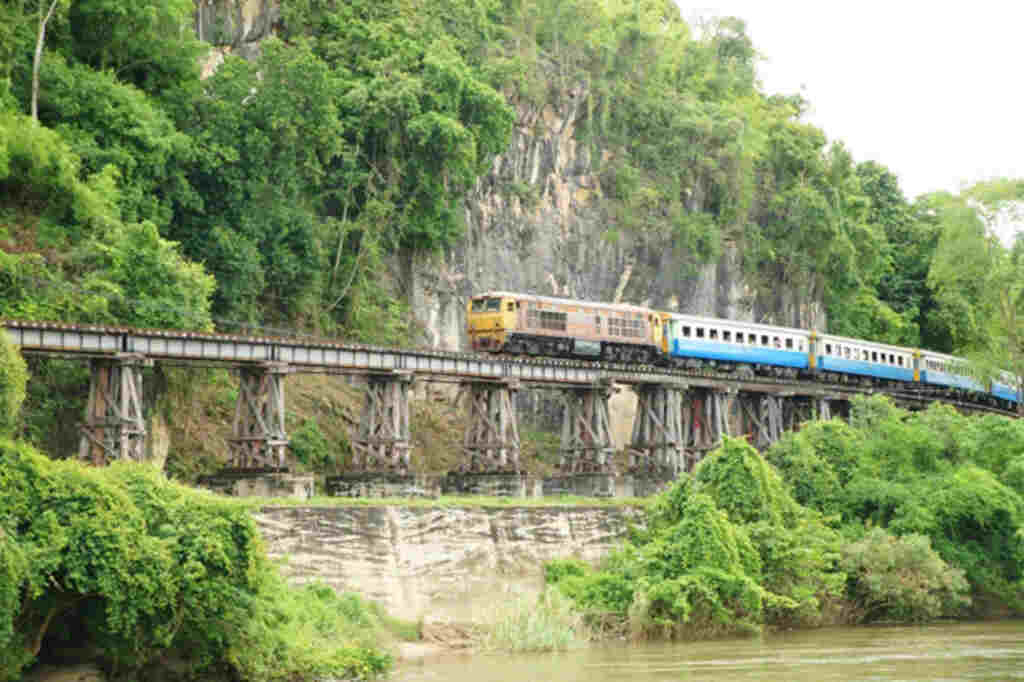On Tuesday, a New Zealand tourist died after falling from a train while taking a selfie on the scenic route of the Death Railway in western Thailand’s Kanchanaburi Province. Police received a report that a passenger had fallen from the train as it passed Krasae Cave.
When police and rescue volunteers arrived, they discovered the passenger’s body 8 meters below the track.
Patrick Ward, 45, of New Zealand, was identified as the suspect, according to Sai Yok police chief Pol Col Puchong Narong-in.
According to witnesses, the tourist took the train from Muang district’s River Kwai station to Sai Yok district’s Nam Tok station.
According to witnesses, the man opened a train door to take a selfie as the train moved at a very slow speed on the Death Railway’s renowned wooden railway bridge, but he suddenly slipped and fell from the train.
Trains move slowly across the 400-metre wooden railway bridge, allowing passengers to take in the scenery before arriving at Tham Krasae station.
The tourist’s body was sent to the Institute of Forensic Medicine at Police General Hospital in Bangkok for an autopsy, according to police, and the New Zealand embassy in Bangkok was notified.
History of the Death Railway
The Thailand-Burma Railway was dubbed the “Death Railway” because over 100,000 laborers died during its 16-month construction between 1942 and 1943.
The railway began in Ban Nong Pla Dook, Ban Pong District, Ratchaburi and continued through Kanchanaburi to the Thailand-Burma border, following the “Three Pagodas” until Thanbyuzayat in Burma.
Initially, the laborers were Burmese, Malaysian, Indonesian, Chinese, and Thai; however, they encountered numerous problems, including torrential rain, which caused the bridge to collapse, diseases, a lack of food, and bombs. Many workers were killed, and the railway was also destroyed.
The Japanese Forces altered their plan by forcing approximately 50,000 British, Australian, American, Dutch, and Irish prisoners of war, as well as over 275,000 workers, to build the strategic railway crossing through Burma. The railway line had to cross the Kwae Yai River.
This construction was fraught with difficulties. The construction was completed until the bridge crossed the Kwae Yai River, at which point a temporary wooden bridge was built. The building process was non-stop.
The prisoners of war took turns throughout the day, 24 hours a day, under the close supervision of the soldiers. Tham Kra-Sae Bridge was one of the most difficult obstacles.
During this phase of construction, the railway encountered steep mountains adjacent to the Kwae Yai River. Japanese engineers were required to construct a railway along the river with the 400-meter-long mountains where approximately 1,000 prisoners died.
It was the railway’s longest crossing-abyss bridge. It was finished in a very short amount of time. Prisoners of war worked inhumane hours under the orders of Japanese prison guards.
The term “speedo” or “keep going” was used to describe this.
The construction was completed quickly in April 1943 because the Japanese Forces wanted it completed by August, which was set as a construction deadline.
POWs and Asian workers were punished and forced to work until late at night. The light from the fire shone through the skinny bodies of the workers in the Hellfire Pass area. It was the inspiration for the names “Hellfire Pass” and “Chongkhao Khat”.
Construction of the Death Railway, the station starts from Nong Pla Duk, Ban Pong District, Ratchaburi Province, passes through Kanchanaburi Province across the Khwae Yai River to the west through three pagodas until the destination Tanbi Usayat, Myanmar, with a length of approximately 415 kilometers, 37 stations, and was completed on October 25, 1943.
Thong Chang Station, Tham Phi, Hin Tok, Kan New, Sai Yok, King Sai Yok, Rien Tin, Kui, Hin Dat, Prang Ka Si, Tha Khanun, Nam Joon Yai, Tha Mayo, Tamron Pha To, Ban Kriengkrai, Kurikonta, Kongkuita, Timonta, Nike, Tsongalia, and the Three Pagodas Pass are all World War II train stations.
When Japan declared war, British troops had demolished 30 kilometers of railways in Burma and 6 kilometers of railways in Thailand, rendering these railways inoperable.
Following that, the Thai government purchased this railway and related equipment for 1,250,000 pounds (50 million baht) and restored it until it could operate vehicles; however, they dismantled some rails, namely those along Thailand’s border with Burma.
The Thai government can only restore and repair the train up to the waterfall station because the Thai government lacks the budget to build the rest of the path, causing the rest of the path to be severely dilapidated.
The rest of the railway had now turned into a forest.







